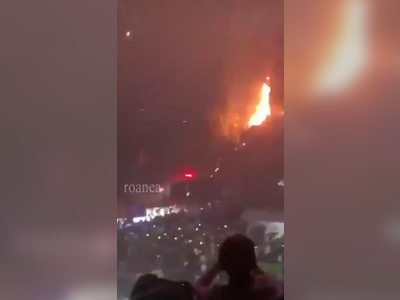Illegal Mining Crisis in South Africa: Tragedy Strikes at Buffelsfontein Gold Mine
More than 100 dead and 500 trapped in an abandoned mine in South Africa underscore the lethal outcomes of poverty-induced illegal mining.
At least 100 illegal miners have perished, and over 500 remain trapped underground at the Buffelsfontein Gold Mine near Stilfontein, South Africa. This tragic event highlights the dangers and desperation faced by illegal miners.
These miners, known as 'zama zamas,' have been stuck for months in one of the deepest and most intricate mines in the country, leading to widespread criticism of the government's handling of the situation.
A Crisis of Desperation
The disaster began in November 2024 when the South African police initiated an operation to remove illegal miners from the abandoned gold mine.
Many of these miners, former employees who lost jobs after the mine closed, returned to retrieve leftover gold deposits to survive.
Their predicament mirrors a broader economic issue in a country where mining layoffs have contributed to severe poverty in gold-rich regions.
Police actions to evict the miners included cutting off their ropes and food supplies.
Critics, including the Mining Affected Communities United in Action (MACUA), condemned these measures as inhumane, effectively trapping hundreds underground.
Footage recorded by escaping miners showed the dire conditions, with bodies wrapped in plastic and emaciated survivors pleading for assistance.
A miner’s voice in the video starkly stated: 'This is hunger. People are dying because of hunger.'
Rescue Efforts and Rising Death Toll
Since Friday, authorities and community-led efforts have recovered 18 bodies and rescued 26 miners.
Despite these efforts, estimates suggest more than 500 individuals remain underground.
The mine, 2.5 kilometers (1.5 miles) deep, is a maze of shafts and tunnels, complicating rescue operations.
Preliminary autopsy reports indicated that starvation and dehydration were the primary causes of death.
Illegal miners often remain underground for long durations, relying on brought supplies and surface support.
In this situation, many crawled through tunnels for days to reach safety, risking collapse and exhaustion.
Government Response and Legal Action
MACUA successfully won a court ruling in December requiring the police to provide food, water, and medical supplies to the miners.
However, delays in executing the court's decision worsened the crisis.
Sabelo Mnguni, a MACUA spokesperson, criticized the government’s approach: 'The miners return to the mine because they live in poverty. They are not criminals but victims of an economy that has failed them.'
South African authorities have struggled to address the challenges of illegal mining, which is often linked to criminal syndicates and violence.
Over 1,500 illegal miners have been arrested in the region since the operation began.
This case, however, underscores the delicate balance between addressing illegal activity and exacerbating human suffering.
The Economics of Illegal Mining
Illegal mining, a widespread issue in South Africa, arises from the closure of once-profitable mines, leaving vast reserves untapped.
Former miners, driven by poverty, risk their lives to extract residual gold deposits.
These miners, called 'zama zamas,' operate in hazardous conditions without proper equipment or oversight.
Experts estimate that illegal mining costs South Africa's economy billions of dollars annually.
However, addressing the issue requires balancing economic priorities with humanitarian concerns.
While authorities have targeted criminal syndicates that exploit zama zamas, critics argue that insufficient efforts address root causes like unemployment and systemic inequality.
Social and Political Repercussions
The Buffelsfontein tragedy has sparked widespread outrage, with calls for greater government accountability.
Advocacy groups argue that the miners’ deaths were preventable, pointing to delayed rescue operations and insufficient safety measures as factors.
International bodies have also criticized South Africa’s response, raising broader concerns about human rights and economic justice.
The tragedy has become a focal point in debates about resource management, labor rights, and the obligation of mining companies to rehabilitate abandoned sites.
Moving Forward: Policy and Reform
Delegations from South Africa’s police and mineral resources ministries plan to visit the site, promising to rescue the remaining miners.
The incident has revived discussions about reforming mining regulations, enhancing safety standards, and investing in alternative livelihoods for affected communities.
Mnguni and other advocates call for a comprehensive approach to address illegal mining, with a focus on economic support for former workers, stricter action against criminal syndicates, and greater corporate accountability for mine closures.
'This tragedy must serve as a wake-up call,' said Mnguni. 'We cannot continue to sacrifice lives to negligence and poverty.'
These miners, known as 'zama zamas,' have been stuck for months in one of the deepest and most intricate mines in the country, leading to widespread criticism of the government's handling of the situation.
A Crisis of Desperation
The disaster began in November 2024 when the South African police initiated an operation to remove illegal miners from the abandoned gold mine.
Many of these miners, former employees who lost jobs after the mine closed, returned to retrieve leftover gold deposits to survive.
Their predicament mirrors a broader economic issue in a country where mining layoffs have contributed to severe poverty in gold-rich regions.
Police actions to evict the miners included cutting off their ropes and food supplies.
Critics, including the Mining Affected Communities United in Action (MACUA), condemned these measures as inhumane, effectively trapping hundreds underground.
Footage recorded by escaping miners showed the dire conditions, with bodies wrapped in plastic and emaciated survivors pleading for assistance.
A miner’s voice in the video starkly stated: 'This is hunger. People are dying because of hunger.'
Rescue Efforts and Rising Death Toll
Since Friday, authorities and community-led efforts have recovered 18 bodies and rescued 26 miners.
Despite these efforts, estimates suggest more than 500 individuals remain underground.
The mine, 2.5 kilometers (1.5 miles) deep, is a maze of shafts and tunnels, complicating rescue operations.
Preliminary autopsy reports indicated that starvation and dehydration were the primary causes of death.
Illegal miners often remain underground for long durations, relying on brought supplies and surface support.
In this situation, many crawled through tunnels for days to reach safety, risking collapse and exhaustion.
Government Response and Legal Action
MACUA successfully won a court ruling in December requiring the police to provide food, water, and medical supplies to the miners.
However, delays in executing the court's decision worsened the crisis.
Sabelo Mnguni, a MACUA spokesperson, criticized the government’s approach: 'The miners return to the mine because they live in poverty. They are not criminals but victims of an economy that has failed them.'
South African authorities have struggled to address the challenges of illegal mining, which is often linked to criminal syndicates and violence.
Over 1,500 illegal miners have been arrested in the region since the operation began.
This case, however, underscores the delicate balance between addressing illegal activity and exacerbating human suffering.
The Economics of Illegal Mining
Illegal mining, a widespread issue in South Africa, arises from the closure of once-profitable mines, leaving vast reserves untapped.
Former miners, driven by poverty, risk their lives to extract residual gold deposits.
These miners, called 'zama zamas,' operate in hazardous conditions without proper equipment or oversight.
Experts estimate that illegal mining costs South Africa's economy billions of dollars annually.
However, addressing the issue requires balancing economic priorities with humanitarian concerns.
While authorities have targeted criminal syndicates that exploit zama zamas, critics argue that insufficient efforts address root causes like unemployment and systemic inequality.
Social and Political Repercussions
The Buffelsfontein tragedy has sparked widespread outrage, with calls for greater government accountability.
Advocacy groups argue that the miners’ deaths were preventable, pointing to delayed rescue operations and insufficient safety measures as factors.
International bodies have also criticized South Africa’s response, raising broader concerns about human rights and economic justice.
The tragedy has become a focal point in debates about resource management, labor rights, and the obligation of mining companies to rehabilitate abandoned sites.
Moving Forward: Policy and Reform
Delegations from South Africa’s police and mineral resources ministries plan to visit the site, promising to rescue the remaining miners.
The incident has revived discussions about reforming mining regulations, enhancing safety standards, and investing in alternative livelihoods for affected communities.
Mnguni and other advocates call for a comprehensive approach to address illegal mining, with a focus on economic support for former workers, stricter action against criminal syndicates, and greater corporate accountability for mine closures.
'This tragedy must serve as a wake-up call,' said Mnguni. 'We cannot continue to sacrifice lives to negligence and poverty.'























